The National Academy of Sports Medicine (NASM) came to Reflection Software with an idea to develop a card game that could augment their online Certified Wellness Coach course.
NASM’s Certified Wellness Coach (CWC) program is built around the recognition that nutrition and fitness is only a small part of how people work to transform their personal well-being. Coaches who go through the online program learn many core concepts, including how to help clients through movement beyond traditional exercise; way to implement healthy dietary patterns that are more intuitive and holistic rather than counting calories or macros; and how to manage stress and social interactions in ways that enrich our lives.
As NASM developed the online portion of the program, it became clear that learners would benefit from an additional level of engagement beyond the traditional asynchronous online learning approach to help coaches focus on building up soft skills and empathy. To bridge this gap, NASM decided that a physical role-playing card game would be the perfect complement to the virtual online learning experience.
The card game was titled “Self-Elficacy: A Wellness Coaching Role-Playing Card Game” and added a dimension of play and exploration that allowed coaches to get comfortable role- playing and practicing conversations with their clients in a risk-free environment. The “elf” element was added just for some extra fun!
NASM needed a partner who could create dynamic graphics, develop a layout for the cards, and assist with the assets needed for the actual production of the physical cards. Through our partnership on previous projects, they knew our visual art style and imagination could bring their vision to life.
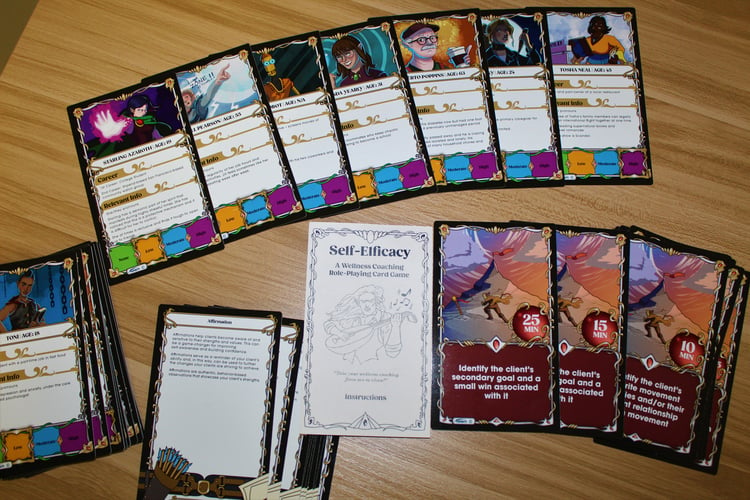
Game Mechanics
The game is played solo or with two players. As a solo player, you’ll consider various objectives to mimic how you might prepare for a meeting with a random client you’ve pulled from the deck. The two-player game is a more traditional role-playing game. Player one, the coach, receives an objective or a goal to work on with their client, Player two. Player two grabs a character card and assumes the role of that character, keeping certain aspects away from the coach until the coach probes to reach their objective. The objectives are of various lengths to allow for multiple playing sessions or a longer session – whatever the time allows. We also included a toolbelt set of cards to remind our players what tools they can use to reach their objective.
Coach Objective Cards
These cards list out various goals/objectives that the coach will be working through in conjunction with the client and toolbelt cards, and a time limit for how long they have to complete the objective. These objectives correlate with what the learner has learned through the Certified Wellness Coach online program. Examples of objectives on the cards are "Identify the client’s primary goal and a small win associated with it (15 minutes)" or "Identify the client’s relationship with stress (5 minutes)".
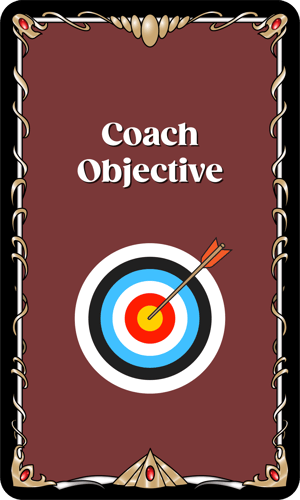
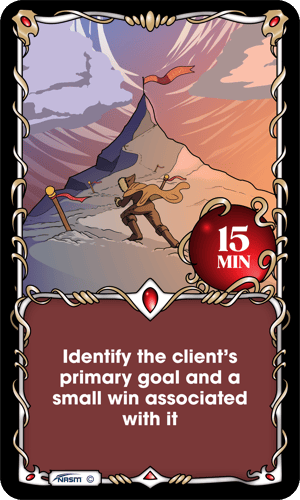
Client Cards
The client cards contain detailed information about the client and their lifestyle, which the coach can use to then support the client with achieving their objective. Each client card is unique, so it's important for the coach to really examine every detail to practice having a conversation and achieve the objective.
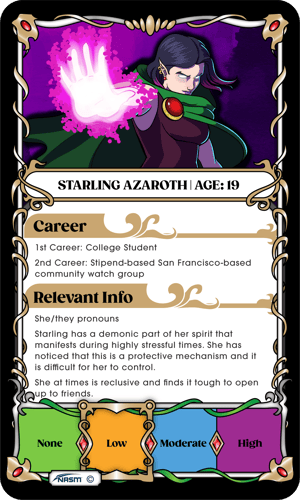
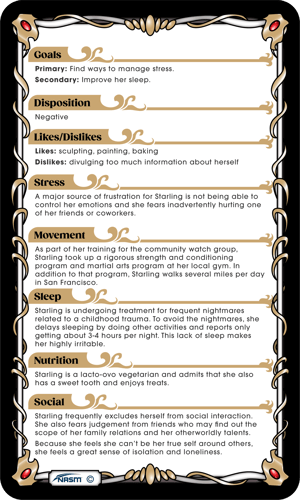
Toolbelt Cards
Think of these cards like extra reminders or "power up" cards that remind the coach about important information they learned during their online CWC course. For instance, if they forgot what the Spectrum of Behavioral Capacity and Autonomy entails, the entire spectrum is listed on one of the Toolbelt cards; so, if they pick that one up, they can see the details in full which may help them get the client to their objective more quickly/efficiently.
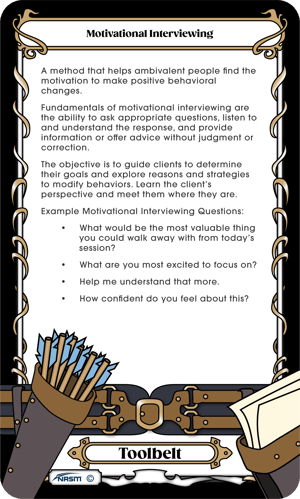
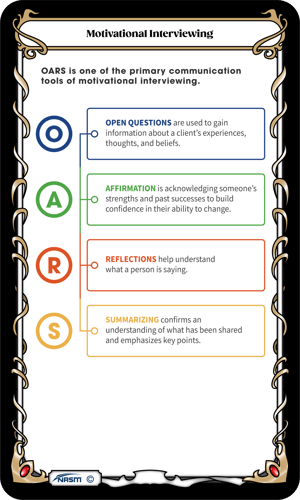
Development & Implementation
Our team took over the role of creative direction and development using the content, gameplay mechanics, and theme that NASM provided us. The development process involved many touch points to ensure there is no miscommunication between vision and execution.
Initial Concept Art & Style Guide
Our team began with an initial research and discovery phase. This included our team assessing the content and drawing proofs for each of the three card type designs.
We created a sketch to show how we thought the front and back of the cards should look and feel. We then sent those sketches to NASM so they could grade our interpretation of their vision, and we could then modify as necessary. Once the sketches were approved, we created an updated colorized version for NASM to review. We wanted to make sure the color grading and even the borders of the images were detailed and representative of the theme.

Our Creative Art Director, Peter Stout, used a combination of all the fantasy designs he has seen in his lifetime. He also researched current trends in media to create characters that would be recognizable in today's pop culture.
Production Process
This process involves three parts: Physical Print Test, Peer Review, and a Layman Review.
The physical print test helps to ensure the design and all of the necessary information fits on the card, but most importantly, it helps to make sure the design works in real life. Some designs may look good on a computer screen, but that doesn’t necessarily mean that it works on paper. We use this test to get the legibility of the text, vibrancy of the colors, and the readability of the design correct. We run this test several times during production to make sure any design changes that are made will still work once the final product is approved.
To follow up on the physical print test, we start conducting our peer reviews. Even the best designer in the world is still going to miss some details. After working on a project for a long time you become so close to it that you might not see the issues it has. Having a fellow designer take a look at what you’ve made and tell you if there are any technical issues you might have missed is extremely valuable.
To finalize our production process, we introduce a layman review when we are close to the finish line. If you pulled a random stranger in and handed them your design, they should be able to understand the information on your design and use it without any explanation from you. The layman will let you know if the design works and if the information has been conveyed effectively through whether or not they understand the product at first glance. This is meant to bring fresh eyes to the project and test your design to see if it gets the desired result you want from an unbiased point of view.
Result
Creating this card game in partnership with NASM was a real honor and provided an exciting opportunity to broaden what “training” can look like.
Jeri Dow from NASM had some very kind words once our project finalized, she expressed, “Finding a group like Reflection to work with is key. Having a partner to help create this and bring it to life was invaluable. I constantly appreciate the creativity, excitement, and thoughtfulness the team at Reflection brings to our work together.”
This card game has brought a new level of engagement and an opportunity for NASM’s learners to practice their skills through play! NASM is excited to be rolling out this game to their on-screen users and to announce the release of the Self-Elficacy: Wellness Coaching Role-Playing Card Game to the general public later this year.